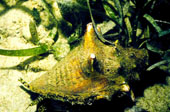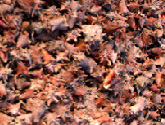Queen Conch (Strombus gigas)

Queen Conch
(Strombus gigas)
Photo: NOAA

Queen Conch Range Map
(click for larger view PDF)
Did You Know?
- The queen conch's shell continues to thicken throughout its life.
- When carrying oxygen, the queen conch's blood appears blue because it contains the copper-containing molecule, hemocyanin.
|
Weight:
|
5 pounds (2.3 kg) |
|
Length:
|
1 foot (30 cm) |
|
Appearance:
|
spiral-shaped shell with a glossy pink or orange interior |
|
Lifespan:
|
generally 20-30 years, though they can live up to 40 years |
|
Diet:
|
algae and detritus |
|
Behavior:
|
they reproduce through internal fertilization and females lay long egg masses that contain hundreds of thousands of eggs |
The queen conch is a large, marine, gastropod mollusk. Mollusks (from the Latin word molluscus, meaning "soft") are a phylum of invertebrates with over 100,000 known species. The majority of mollusks, including queen conch, are of the Class Gastropoda, whose name translates from Latin as "stomach foot." Other types of mollusks include oysters, clams, octopus, and squid.
Mollusks are soft-bodied animals that may have a hard external shell composed of calcium carbonate, a hard internal shell, or no shell at all. Queen conchs have an external, spiral-shaped shell with a glossy pink or orange interior.
Queen conchs achieve full size at about 3-5 years of age, growing to a maximum of about 12 inches (30.4 cm) long and weighing about 5 pounds (2.3 kg).
Queen conchs have separate sexes and reproduce through internal fertilization. After mating, females lay long egg masses that contain hundreds of thousands of eggs, which hatch after about 5 days. Larvae then spend about 18-40 days floating and feeding in the "plankton" before settling to the bottom and metamorphosing into the adult form. Once in their benthic, adult form, they graze on algae and detritus.
The queen conch is a long-lived species, generally reaching 20-30 years old; however, the lifespan has been estimated as up to 40 years.
Queen conchs are prized for both their edible meat and attractive shell.
The queen conch lives in sand, seagrass bed, and coral reef habitats. It is found in warm, shallow water and is generally not found deeper than 70 feet (21 m). The queen conch is found throughout the Caribbean Sea and Gulf of Mexico, and ranges as far north as Bermuda and as far south as Brazil. Queen conch abundance is declining throughout the species's range as a result of overfishing and poaching. Populations of the species in Honduras, Haiti, and the Dominican Republic, in particular, are currently being exploited at rates that may be unsustainable.- harvest for meat and shells
- There has been increasing concern about the conch fishery as populations have been depleted.
- Queen conch meat is used mainly for consumption but is also used as fishing bait.
- A by-product of the meat trade are conch shells, which are used for jewelry or sold as curios.
- Trade from many Caribbean countries is known or suspected to be unsustainable, and illegal harvest, including fishing of the species in foreign waters and subsequent illegal international trade, is a common and widespread problem in the region (Theile 2001).
Queen conch are managed under national regulation. In the United States, all takes of queen conch are prohibited in Florida and adjacent Federal waters. No international regional fishery management organization exists in the Wider Caribbean. However, in Puerto Rico and the Virgin Islands, queen conch is regulated under the auspices of the Caribbean Fishery Management Council (CFMC) ![]() .
.

Queen Conch, coral, and trumpet triton shells for sale
Photo: Andy Bruckner, NOAA

Empty conch shells are a common sight in areas of intensive harvest
Photo: Andy Bruckner, NOAA
In 1990, the Parties to the Convention for the Protection and Development of the Marine Environment of the Wider Caribbean Region (Cartagena Convention) included queen conch in Annex III of its Protocol Concerning Specially Protected Areas and Wildlife (SPAW Protocol) as a species that may be used on a rational and sustainable basis and that requires protective measures. Because of this recognition, the United States proposed queen conch for listing in Appendix II of the Convention on International Trade in Endangered Species of Wild Fauna and Flora (CITES) in 1992; this proposal was adopted, and queen conch became the first large-scale fisheries product to be regulated by CITES.
Since 1995, CITES has been reviewing the biological and trade status of queen conch under its Significant Trade Review process. Significant Trade Reviews are undertaken when there is concern about levels of trade in an Appendix II species. The Queen Conch Significant Trade Review ![]() is available from CITES. Based on this review, CITES recommended that all countries prohibit the importation of queen conch from Honduras, Haiti, and the Dominican Republic. Queen conch continues to be available from many other Caribbean countries, including Jamaica and the Turks and Caicos Islands (British West Indies), which have well-managed queen conch fisheries.
is available from CITES. Based on this review, CITES recommended that all countries prohibit the importation of queen conch from Honduras, Haiti, and the Dominican Republic. Queen conch continues to be available from many other Caribbean countries, including Jamaica and the Turks and Caicos Islands (British West Indies), which have well-managed queen conch fisheries.
The CITES embargo restrictions on Honduras, Haiti, and the Dominican Republic will be lifted when the countries have taken the following actions:
- Identified areas to be designated for commercial fisheries;
- Undertaken density studies in these designated areas;
- Identified and analyzed trends in available landing data;
- Established a standardized minimum meat weight that corresponds to adult specimens of unprocessed and processed meat; and
- Analyzed, based on the results of the density studies, landing trends and standardized meat weight to establish cautious catch and export quotas in consultation with the CITES Secretariat.
In 1996, the first meeting of the International Queen Conch Initiative ![]() was convened in San Juan, Puerto Rico, supported by the Caribbean Fishery Management Council (CFMC), U.S. Department of Commerce, the Government of the Commonwealth of Puerto Rico, and the Food and Agriculture Organization of the United Nations (FAO). At that meeting, the Declaration of San Juan was adopted, meaning countries in the region pledged to work together to strengthen bilateral, sub-regional, and regional mechanisms to establish common management regimes for the sustainable use of queen conch.
was convened in San Juan, Puerto Rico, supported by the Caribbean Fishery Management Council (CFMC), U.S. Department of Commerce, the Government of the Commonwealth of Puerto Rico, and the Food and Agriculture Organization of the United Nations (FAO). At that meeting, the Declaration of San Juan was adopted, meaning countries in the region pledged to work together to strengthen bilateral, sub-regional, and regional mechanisms to establish common management regimes for the sustainable use of queen conch.
Phylum: Mollusca
Class: Gastropoda
Order: Mesogastropoda
Family: Strombidae
Genus: Strombus
Species: gigas (All documents are in PDF format.)
| Title | Federal Register | Date |
|---|---|---|
| Negative 12-month finding to list queen conch under ESA | 79 FR 65628 | 11/05/2014 |
| Status Review | 2014 | |
| 90-Day Finding on a Petition To List the Queen Conch as Threatened or Endangered Under the Endangered Species Act | 77 FR 51763 | 08/27/2012 |
| WildEarth Guardians Petition to List the Queen Conch under the ESA | n/a | 02/17/2012 |
| Southeast Data, Assessment, and Review (SEDAR 14) | n/a | 2007 |
| Queen Conch Significant Trade Review |
n/a | 2003 |
| Fishery Management Plan, Regulatory Impact Review, and Environmental Impact Statement for Puerto Rico and the U. S. Virgin Islands |
n/a | 1996 |
- NOAA's National Marine Sanctuaries Encyclopedia
- U.S. Fish & Wildlife Service Queen Conch Information
Updated: February 3, 2015


